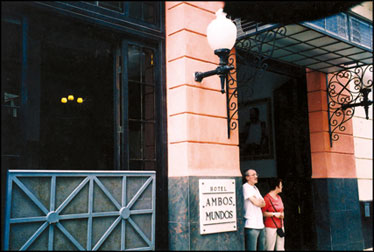Fragrant memories of La Colombiana

Continued from last week
Hemingway never resisted the temptation to pull his yacht into the
cave at El Guincho. On the pier, one could observe the great wooden
wharfs, the electric companies and the one made of old timber that
belonged to the Carreras brothers.
On the same bank, on one side of the Carreras brothers’ pier was
Agustins tavern: and on the other side, leeward, a kind of inn and
canteen, with corridors, terraces and balconies run by woman that
everyone knew as La Colombiana. The stone streets and the colonial
buildings constructed with limestone and coral were covered with a tile
roof.
Ernest Hemingway began to visit this place of experienced fishermen,
turtle hunters and sailors in a port where as soon as the world war
began, it was common to see numerous cargo ships, navy ships, tall sail
boats, gunboats, schooners, and brigs. It was the war years and it was
customary in taverns or in the hotel of the Filgueras family, or in the
splendid El Cato Negro restaurant, to find the captains of merchant
ships, sailors from navy gamblers, merchants, businessmen and officials
of international companies, FBI agents, Mahosos and scoundrels, custom
agents, bank representatives, Germans from Berlin city, adventurers,
sailors and professional swindlers.
 |
|
Hotel Ambos Mundos |
Officials from Insurance Companies, local businessmen, estate owners,
landowners and tenant families, illustrious people of Camaguey, old
sailors from every corner of the world and a lot of travellers:
Europeans and Americans from the cities that they had founded in the
valley of Cubilas, landowners, ranchers and sugar producers who had
arrived on the train at sun rise, and would go ahead to the city of
Camaguey on the evening express. As Hemingway would say years later, in
one of his famous chronicles, in reference to favourite places in
Havana, “Here one could meet by chance some enigmatic character whose
destiny it was to die the next day or a year later,” Of all the
testimonies that Ernest Hemingway offered at the pier of San Fernando de
Nuevitas, the one with the greatest sense of admiration was the one
always told by Augustin et Tuerto (one -eyed Augustin). His favourite,
as mentioned, was windward of that enormous wooden pier, site of former
splendours. On the other side, leeward was the inn of La Colombiana.
And that was all.
La Colombianas inn was the greatest splendour and was always the most
interesting. That silent hermetic woman ruled the building constructed
with oak cedar and mahogany, with a great salon and bar, and eight or
ten tables with chairs, nets and another attached to the wall among
other spoils of the sea. There were 30 spacious rooms, with highly
polished doors and windows which opened to the forces of the breeze, the
salt and the rain. The place had great charm. It also had a touch of
mystery because of these celebrated parties that La Colombiana used to
hold in the years of the World War and because the establishment was
visited on various occasions by the writer Hemingway.
As La Colombiana remembers “Hemingway always gave the impression of
being a solitary sailor dressed like a sailor like on that first
occasion when he came into the port to get drunk in Agustins tavern.
Some years later he made a very special visit.
He approached the counter of the inn and requested the best room,
with wide windows, facing the sea breeze.
La Colombiana remembered how that night, in the days of World War II,
Hemingway waited endlessly, and it was not until the next day that the
movie star Hemingway waiting for appeared. She came very early. She
arrived in a rented car from the Camaguey airport.
The description (both that of La Colombiana, as well as, that of some
fishermen later) was of “a tall woman, blonde, splendid, with a very
pretty face and a large breasts”.
The American would stay inside his room for two days. He requested
rum and ice, and on several occasions he also requested clean sheets and
pillowcases. He ordered plenty of food, in the morning and in the
evening, and more rum and bottles of wine, always with windows of the
room opened to the sea breeze, after the first day he had gone by.
It was the following night that they went out on terrace. They left
the inn and walked toward the restaurant El Gato Negro, the most
exquisite place of the region. To go into spacious salon with its wooden
floors, opened to all the sounds of the sea, beautiful bar, nor the
large windows, nor the grace and elegance of that great restaurant that
captivated Hemingway. The most fascinating thing about it, what most
attracted and excited him about El Gato Negro, according to Augustin,
was the irresistible aroma that always emanated from kitchen. The
splendour of El Gato Negro was in its famous kitchen, attended by a man
from Grand Canary Island. Every time he entered the big door of El Gato
Negro, Hemingway raised his voice and demanded the chef appeared before
him immediately, the chef who officiated over all these miracles in the
place.” Prepare lobster buccaneer-style or pirate-style or however it
suits you,” said Hemingway. Perhaps because of this Hemingway returned
time and again. They knew him from 1930s, and he came on many other
occasions during his stays in Camaguey.
 |
|
Yatch |
And the fishermen and turtle hunters always remembered him from the
time when that girl left the room and went out on terrace. They saw her
defiant.
They watched her walk along the high covered porch. It is said that
the girl stayed there, leaning against the railing, on the side where
schooners pulled up, observing the schools of fish that used to appear
in the cove in the morning. Later Hemingway approached her and gave the
impression that they were exchanging wards, may be arguing, until the
chauffeur appeared who two days earlier had brought her from the
airport.
Then she left the terrace quickly and got in the car without saying
goodbye, while Hemingway went to the bar, paid the bill leaving a good
tip, headed toward the pier to untie his yacht and disappeared quickly.
Augustin used to say that he had known “that American” since 1930. He
remembered him because two years later a great hurricane whipped the
coast.
He also affirmed that he was a man, who was almost always upset, at
times in a very bad mood, often with a strong will to drink. As soon as
he had docked, he went to the tavern. He approached the counter,
barefoot, shirtless, with an old cap, and asked for a bottle of
Matusalen. The clientele of Agustins tavern were avid sailors. They came
anxious to mail a letter, get a shave and haircut, buy something, or
find a woman. That was the case of Spaniards who came to Cayo Sabinal.
They were very strange.
Augustin at times remembered the heated arguments and serious wards
that the Gallelan, Jose, sometimes exchanged with Americans from the
yacht.
With his sun visor, his stories, and an old coloured shirt, Hemingway
would walk all over town, from the pier of El Guincho to the area El
Pauente. Right at that spot, between the activity of the port and the
red light district, the barber shop of Felo Centellas was built years
later, not far from Sloppy Joes of Perecito (where El Dongo used to sing
with his hoarse voice on nights of endless revelry) and close to where
the Prada Hotel and noisy Green Light were located. Hemingway learned
everything to be known about that town.
He arrived unknown, silent, like any other foreigner, one of the many
who passed through the port. He came like many of European immigrants
fleeing the war.
Like many of the Americans in search of lodging, for a room in one of
the hotels. Like many of the Germans who appeared on the evening train,
before they began to be persecuted. Like the English, Italians and
French and other crew members from the furthest corners of the earth.
On one or two occasions Hemingway also stayed in the Miramar Hotel.
It was located at the very edge.
|

